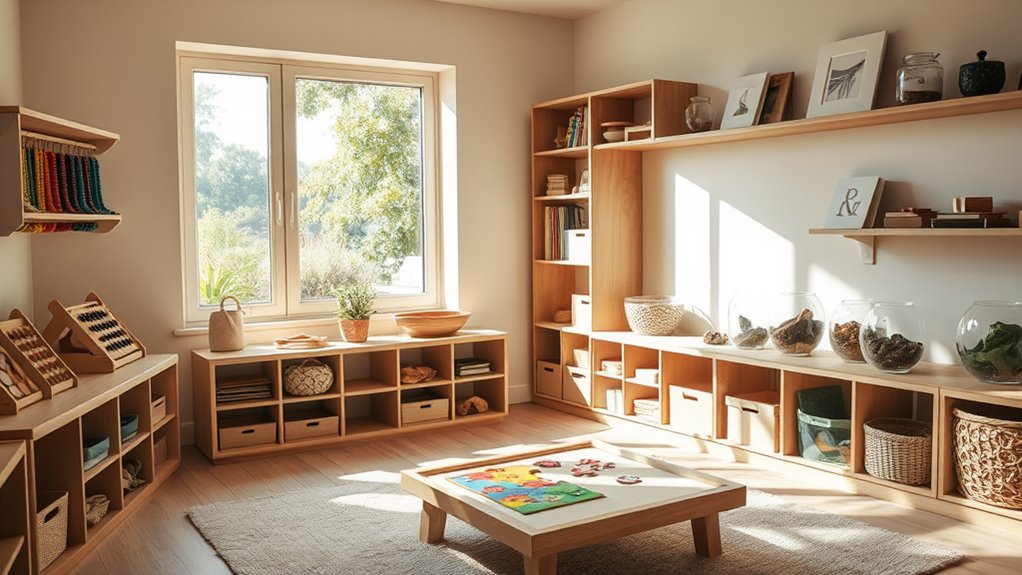Creating a Montessori-Inspired Learning Environment
When you’re thinking about creating a Montessori-inspired learning environment, it’s important to contemplate the core principles that guide this approach. You’ll want to design spaces that promote exploration and independence, using materials that inspire curiosity and hands-on discovery. Imagine how different layouts and natural elements can transform a room into a dynamic learning space. But what specific strategies will help you implement these ideas effectively, and how can you adapt them for various age groups? The answers to these questions could reshape your understanding of education.
Understanding Montessori Principles
Embracing Montessori principles means recognizing the unique ways children learn and grow. You’ll discover that fostering independence and encouraging exploration are at the heart of this educational approach. When you allow children to choose their activities, they engage more deeply, developing a love for learning.
It’s not just about what they learn; it’s about how they learn, and that’s where the magic happens.
Montessori emphasizes hands-on learning, which means kids learn best through real experiences rather than passive listening. You’ll notice that when they engage with materials, they not only grasp concepts but also develop critical thinking skills.
The role of the adult shifts from a traditional teacher to a guide, providing support while letting children take the lead in their education.
Another key principle is respect for each child’s individual pace. You’ll learn that some children may grasp concepts quickly, while others might need more time.
This approach nurtures self-esteem and encourages resilience, essential traits for lifelong learners. By understanding and implementing these principles, you’re setting the stage for a rich, supportive learning environment that respects each child’s unique journey.
Space Layout and Design
Creating a Montessori-inspired environment starts with thoughtful space layout and design. When you’re setting up your learning space, think about how children will interact with their surroundings. Aim for an open layout that encourages movement and exploration.
Arrange furniture to create distinct areas for different activities, like reading, art, and group work, while keeping pathways clear for easy navigation.
Consider the scale of your furniture. Low shelves and tables let children access materials independently, fostering their sense of autonomy. Use natural light whenever possible, as it creates a warm, inviting atmosphere that stimulates learning.
Also, select calming colors for walls and furniture; softer hues help maintain focus and reduce distractions.
Don’t forget about flexibility! A space that can adapt to various activities is essential. You can use movable furniture or modular pieces that can be rearranged based on the day’s needs.
Choosing Appropriate Materials
How do you choose the right materials for a Montessori-inspired learning environment? First, consider the developmental needs of the children you’re working with. Montessori materials should be hands-on, engaging, and encourage exploration. Look for items that promote sensory experiences, like textured fabrics or colorful manipulatives. These materials help children learn through touch and sight, which is essential in their development.
Next, prioritize quality over quantity. Choose durable, safe materials made from natural substances, like wood or metal. These not only enhance aesthetic appeal but also create a warm, inviting atmosphere. Avoid plastic whenever possible, as it tends to detract from the Montessori philosophy of using authentic materials.
Also, think about variety. Your selection should encompass different subjects, such as math, language, and science, allowing children to explore various concepts at their own pace.
Finally, verify the materials are accessible. Arrange them on shelves within reach so that children can independently choose what they want to work with.
Incorporating Natural Elements
Incorporating natural elements into a Montessori-inspired learning environment enhances children’s connection to the world around them. You can achieve this by bringing in materials like wood, stones, plants, and natural fabrics. These elements not only look appealing but also create a calming atmosphere that encourages exploration and creativity.
For instance, consider adding a small indoor garden or potted plants. This not only livens up the space but also teaches children about responsibility and the importance of caring for living things.
Using natural light is another great way to incorporate nature. Arrange your learning areas near windows to maximize sunlight, which can improve mood and focus. You might also want to include natural light filters, like sheer curtains, to soften the glare.
Additionally, consider using natural colors and textures in your decor. Earthy tones, such as greens, browns, and soft blues, can create a warm, inviting environment.
By thoughtfully integrating these elements, you’re not just beautifying the space; you’re fostering a deeper appreciation for nature and encouraging mindfulness.
Promoting Independence and Choice
Why is promoting independence and choice vital in a Montessori-inspired learning environment? It’s all about empowering you to take charge of your own learning. When you have the freedom to choose activities that interest you, it sparks curiosity and motivates you to explore. This independence helps you develop decision-making skills, which are significant for personal growth.
Creating an environment filled with choices means providing a variety of materials and activities that cater to different learning styles. You can select what you want to work on, whether it’s art, science, or reading. This not only makes learning enjoyable but also fosters a sense of responsibility. You learn to manage your time and prioritize tasks, skills that will serve you well in the future.
Encouraging independence also builds confidence. Each time you make a choice and see the results, you gain a little more faith in your abilities.
Plus, when you tackle challenges on your own, you develop problem-solving skills that are fundamental in everyday life. Remember, in a Montessori-inspired setting, your voice matters, and your choices shape your educational journey!
Creating a Calm Atmosphere
A calm atmosphere is key to enhancing your learning experience in a Montessori-inspired environment. When you step into a space that feels peaceful, it allows you to focus better and engage more deeply with your learning materials.
To create this tranquility, start by minimizing distractions. You can do this by reducing noise levels and keeping the environment organized. A tidy space helps maintain clarity in your thoughts and promotes a sense of calm.
Next, consider the lighting. Natural light is ideal, so try to arrange your workspace near a window. Soft, warm lighting can also create a cozy vibe, making you feel more relaxed.
Additionally, incorporating plants or natural elements can enhance this calming effect. They not only improve air quality but also bring a touch of nature into your learning environment.
Encouraging Collaborative Learning
When you foster a collaborative learning environment, you’ll notice how much richer the educational experience becomes. By encouraging teamwork among students, you create opportunities for them to learn from one another. This shared learning not only enhances understanding but also builds essential social skills.
Start by grouping students in pairs or small teams for specific activities. This setup allows them to discuss ideas, share insights, and solve problems together. When they work collaboratively, students often feel more engaged and motivated, as they’re not just learning for themselves but also for their peers.
You can also incorporate project-based learning, where groups tackle real-world challenges. This approach encourages creativity and critical thinking, as each member brings unique strengths to the table.
Don’t forget to celebrate their teamwork! Acknowledge their efforts and achievements, fostering a sense of community and belonging. You might even consider rotating roles within groups to guarantee everyone experiences different aspects of collaboration.
In doing so, you’ll not only help students grasp academic concepts more effectively but also prepare them for future collaborative endeavors in school and beyond.
Embrace the power of collaboration, and watch your students thrive!
Designing Activity Zones
Creating dedicated activity zones in your classroom can greatly enhance the learning experience. By dividing your space into specific areas, you encourage children to engage with different materials and activities purposefully.
Think about creating zones for art, science, reading, and sensory play. Each zone should be clearly defined, using furniture or rugs to mark boundaries. This way, students know where to go for specific activities.
In the art zone, include various supplies like paints, clay, and paper, allowing creativity to flow. The science zone can feature experiments and nature exploration materials, fostering curiosity.
Don’t forget a cozy reading nook filled with books that pique interest, inviting students to immerse themselves in stories. Sensory play can happen in a designated area with textured materials, water play, or building blocks, promoting fine motor skills.
Ensure that each zone is stocked with age-appropriate resources, allowing children to explore independently. You’ll find that this setup not only encourages self-directed learning but also helps students develop their interests.
Ultimately, well-designed activity zones create a vibrant learning atmosphere, allowing every child to thrive and discover their unique passions.
Adapting to Different Age Groups
Understanding children’s developmental stages is essential for adapting your Montessori-inspired learning environment to different age groups.
When you’re designing spaces for toddlers, focus on safety and exploration. Use low shelves filled with soft toys and simple puzzles to encourage their natural curiosity.
As children grow into preschoolers, you can introduce more complex activities, such as art stations and basic science experiments, which promote creativity and critical thinking.
For early elementary-aged children, consider offering materials that support independent learning. Books, math games, and hands-on science kits can empower them to explore at their own pace.
Make certain that your environment allows for collaboration as well; group projects can foster social skills and teamwork.
As children reach the upper elementary stage, they need more challenging tasks that promote deeper understanding.
Incorporate research projects, advanced math manipulatives, and opportunities for creative expression.
Verify that your space reflects their growing independence by allowing them to choose their materials and manage their time.
Continuous Observation and Assessment
Continuous observation and assessment are essential components of a Montessori-inspired learning environment. As you create this space, you’ll want to keep a close eye on each child’s progress and interests. This ongoing observation helps you understand their unique learning styles, allowing you to tailor experiences that engage and inspire them.
Instead of relying solely on tests or quizzes, you’ll notice how children interact with materials, their peers, and the environment. By paying attention to these interactions, you can identify areas where they thrive and where they may need additional support. It’s all about fostering a love for learning while ensuring each child feels valued and understood.
You’ll also want to document your observations. Whether it’s through notes, photographs, or checklists, keeping track of each child’s journey allows you to reflect on their growth and adapt your approach. This process not only benefits the children but enhances your skills as an educator.
In a Montessori setting, the aim is to create a nurturing atmosphere where children feel safe to explore. Continuous observation and assessment are your tools to make that happen, guiding them toward their fullest potential.





